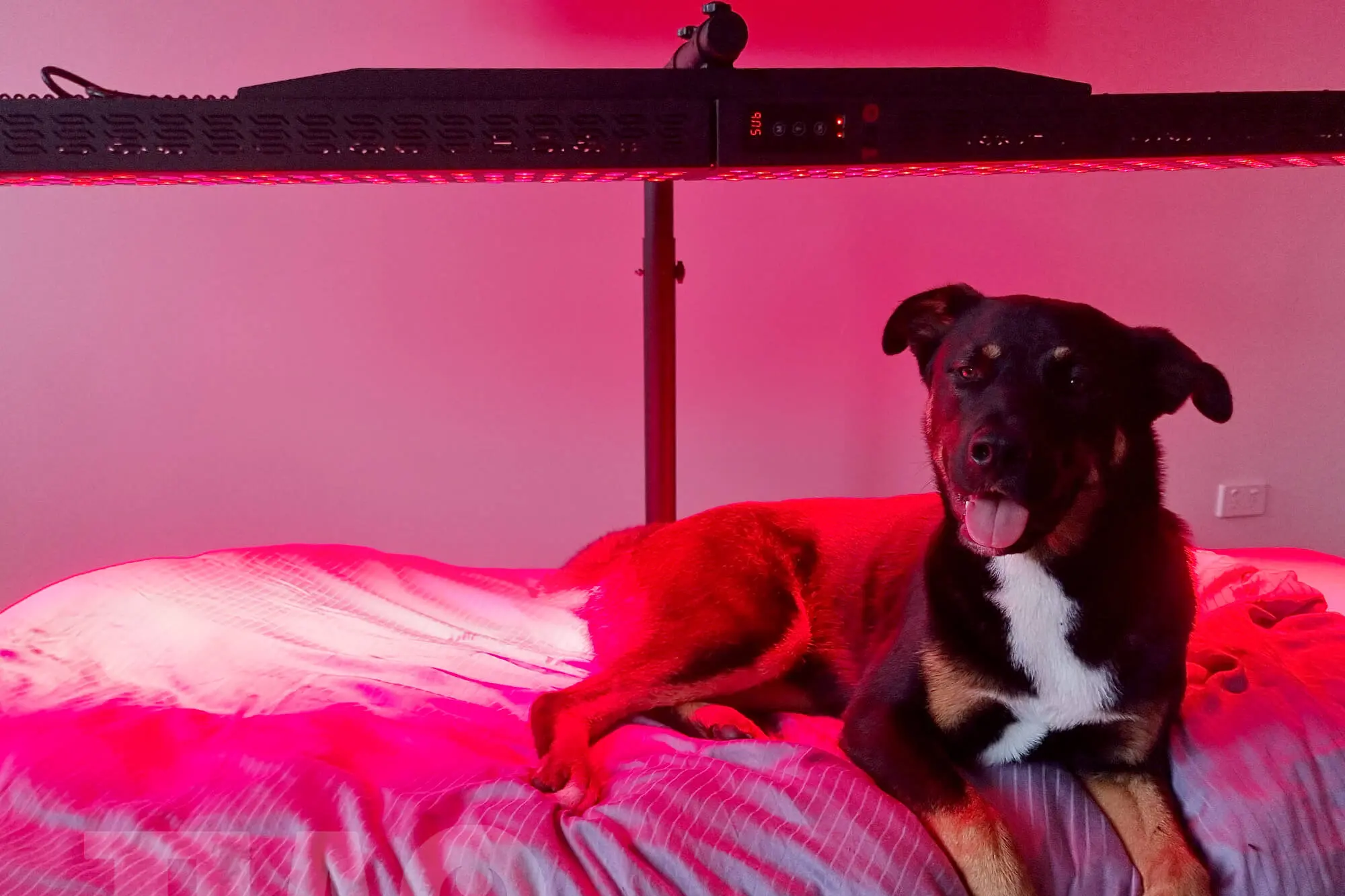What is Red Light Therapy (RLT)?
Red Light Therapy (RLT), also known as Low-Level Light Therapy (LLLT) or photobiomodulation, is a non-invasive and drug-free treatment method that utilizes specific wavelengths of red and near-infrared light to promote healing and alleviate various health issues in dogs. These light wavelengths penetrate the skin and are absorbed by cells, stimulating a series of biological responses that contribute to tissue repair, pain reduction, and overall wellness.
Brief History and Development of RLT in Veterinary Medicine
The use of light as a healing agent dates back centuries, with ancient cultures like the Egyptians and Greeks employing sunlight to treat various ailments. However, it was not until the late 1960s when Endre Mester, a Hungarian physician and researcher, accidentally discovered the beneficial effects of low-level laser therapy on wound healing in mice. This groundbreaking discovery laid the foundation for further research on light therapy.
Over the years, advancements in technology and research have expanded the applications of light therapy in both human and veterinary medicine. Veterinarians began exploring the potential benefits of RLT for animals, including dogs, and found that it could be a valuable adjunct to traditional treatments, aiding in the management of numerous conditions.
Purpose of the Article and its Importance for Dog Owners
The purpose of this article is to shed light on the emerging field of Red Light Therapy for dogs, providing a comprehensive understanding of its mechanisms, benefits, and applications. As pet owners increasingly seek alternative and complementary therapies for their furry companions, RLT has gained popularity for its non-invasive nature and minimal side effects.
This article aims to educate dog owners about the various ways RLT can positively impact their pets’ health and well-being. By delving into the scientific principles behind this therapy and presenting real-life success stories, dog owners can make informed decisions about integrating RLT into their dogs’ healthcare routines.
Ultimately, the article seeks to emphasize the importance of responsible and knowledgeable use of Red Light Therapy for dogs. While RLT can offer numerous advantages, it is essential to collaborate with veterinarians and ensure that it complements, rather than replaces, conventional veterinary care. By exploring the potential of RLT, dog owners can potentially enhance their pets’ quality of life and provide them with the best possible care.
Understanding Red Light Therapy
Explaining the Science Behind Red Light Therapy
Red Light Therapy operates on the principle of photobiomodulation, a process where specific wavelengths of red and near-infrared light interact with cells, tissues, and biological molecules in the body. When the red and near-infrared light is absorbed by the cells’ mitochondria, it enhances cellular energy production, leading to various therapeutic effects.
The light wavelengths used in RLT range between 600 to 1000 nanometers. Red light, around 600 to 700 nm, primarily penetrates superficial tissues, making it effective for skin-related conditions. On the other hand, near-infrared light, ranging from 700 to 1000 nm, has greater tissue penetration, allowing it to address deeper issues like muscle and joint problems.
Different Types of Light Therapy and Their Applications
- Low-Level Laser Therapy (LLLT): LLLT involves the use of laser devices that emit coherent light. It is generally used for targeted treatments, such as wound healing, arthritis management, and tissue repair. Veterinarians often utilize LLLT in specific areas, providing localized therapeutic effects.
- Light Emitting Diode (LED) Therapy: LED therapy uses non-coherent light sources, making it more suitable for larger treatment areas or whole-body applications. LED devices are commonly used for general wellness, skin conditions, and enhancing overall circulation.
- Combination Therapy: Some RLT devices combine both lasers and LEDs to provide a broader spectrum of light wavelengths. Combination therapy can offer a more versatile approach, addressing various conditions simultaneously.
Mechanisms of Action and How RLT Affects Canine Physiology
- Cellular Energy Boost: When red and near-infrared light is absorbed by the mitochondria, it stimulates the production of adenosine triphosphate (ATP), which is the primary energy source for cells. This increased energy production enhances cellular function and accelerates the healing process.
- Reduction of Inflammation: RLT has been shown to reduce inflammation by inhibiting specific pro-inflammatory cytokines and promoting anti-inflammatory cytokines. This helps alleviate pain and swelling associated with various conditions, including arthritis and soft tissue injuries.
- Promotion of Circulation: Red light therapy encourages vasodilation, which widens blood vessels, leading to improved blood flow and oxygen delivery to tissues. Enhanced circulation supports tissue repair and helps remove waste products, aiding in recovery.
- Stimulation of Collagen Production: Collagen is a vital component of connective tissues, and RLT stimulates fibroblasts to produce collagen. This is particularly beneficial for wound healing, tissue repair, and improving skin health.
- Nerve Regeneration: Red light therapy has shown promise in promoting nerve regeneration and nerve function recovery. This can be valuable in managing nerve-related conditions and neurodegenerative disorders.
Understanding the underlying mechanisms of action allows dog owners to appreciate the science behind red light therapy and its potential applications. With this knowledge, they can make informed decisions about incorporating RLT as part of their dog’s healthcare regimen, working in collaboration with veterinarians for the best possible outcomes.
The Benefits of Red Light Therapy for Dogs
Red Light Therapy has emerged as a powerful and versatile treatment method for dogs, offering a range of benefits that contribute to their overall health and well-being. This non-invasive and safe approach to healing has gained popularity in veterinary medicine due to its effectiveness and minimal side effects. Let’s delve into the remarkable advantages that Red Light Therapy can provide for our canine companions:
Pain Management and Reduction of Inflammation
- Easing Joint Pain and Arthritis in Aging Dogs: As dogs age, they may develop joint pain and stiffness, often caused by arthritis. Red Light Therapy has shown remarkable results in reducing inflammation in affected joints, providing relief to older dogs and improving their mobility and comfort.
- Alleviating Discomfort from Injuries and Surgeries: After surgeries or injuries, dogs can experience pain and swelling. Red Light Therapy aids in reducing inflammation and promoting faster healing, easing the discomfort associated with these conditions and helping dogs recover more rapidly.
Accelerating Wound Healing
- Enhancing Cell Regeneration and Tissue Repair: Red Light Therapy stimulates the production of ATP, the energy source for cells, which accelerates cellular regeneration and tissue repair. This effect is particularly beneficial for wounds, cuts, and post-surgical incisions, promoting faster healing and reducing scarring.
- Treating Skin Conditions and Hotspots: Dogs are susceptible to skin issues, such as dermatitis and hotspots. Red Light Therapy can soothe inflamed skin, reduce itching, and aid in the healing of skin conditions, providing relief to the affected areas.
Promoting Healthy Skin and Coat
- Addressing Dermatological Issues: Red Light Therapy has demonstrated efficacy in addressing various skin conditions in dogs, including allergies and eczema. By reducing inflammation and promoting cell repair, RLT can help improve overall skin health.
- Enhancing Coat Growth and Luster: Proper blood flow is essential for healthy hair follicles. Red Light Therapy enhances circulation to the skin, supporting coat growth, and enhancing its shine and texture.
Improving Circulation and Blood Flow
- Enhancing Cardiovascular Health: By improving blood circulation, Red Light Therapy contributes to better cardiovascular health in dogs. Proper blood flow ensures that vital organs receive sufficient oxygen and nutrients, supporting overall heart health.
- Aiding in Overall Well-being and Vitality: The increased oxygenation of tissues due to improved blood flow can boost a dog’s energy levels and overall vitality, enhancing their quality of life.
The myriad of benefits offered by Red Light Therapy makes it a valuable treatment option for dogs, especially when traditional methods may be limited or have undesirable side effects. However, it is crucial to consult with a veterinarian before implementing RLT to ensure its suitability for a specific condition and to determine the correct treatment parameters. With the right guidance and application, Red Light Therapy can significantly contribute to the health and happiness of our beloved canine companions.
Red Light Therapy Equipment for Dogs
Red Light Therapy equipment for dogs comes in various forms and configurations, designed to address specific conditions and treatment areas. As the popularity of RLT grows in veterinary medicine, understanding the available options and safety considerations becomes essential for dog owners and veterinarians alike.
Different Types of RLT Devices Available
- Handheld Devices: Handheld RLT devices are portable and easy to use. They are suitable for localized treatments, making them ideal for addressing specific areas of pain, wounds, or skin conditions. These devices typically use LED technology and are user-friendly for home use.
- Panel or Pad Devices: Panel or pad RLT devices feature a larger treatment area and can cover more significant parts of a dog’s body. They may incorporate both red and near-infrared light wavelengths for versatile applications. These larger devices are often used in veterinary clinics for more extensive treatments.
- Full-Body Devices: Full-body RLT devices are designed to treat the entire body simultaneously. These devices are commonly used in veterinary clinics or rehabilitation centers and provide comprehensive treatment for multiple conditions.
Understanding the Appropriate Light Wavelengths for Different Conditions
The effectiveness of Red Light Therapy depends on using the appropriate light wavelengths for specific conditions. Red light, around 600 to 700 nm, is more suitable for superficial tissues and skin-related issues, while near-infrared light, ranging from 700 to 1000 nm, has greater tissue penetration and is beneficial for deeper issues like muscles and joints.
Different conditions may require different combinations of wavelengths, and the duration and frequency of treatment can vary accordingly. It’s essential to consult with a veterinarian or a trained professional to determine the most suitable wavelengths and treatment parameters for a dog’s specific health condition.
Safety Considerations and Precautions When Using RLT on Dogs
While Red Light Therapy is generally safe for dogs, there are essential safety considerations and precautions to keep in mind:
- Eye Protection: Direct exposure of a dog’s eyes to the RLT light can be harmful. It is crucial to use appropriate eye protection or ensure that the eyes are shielded during treatment.
- Avoid Overheating: Prolonged exposure to RLT may lead to overheating of the treated area. Monitoring the dog during treatment and avoiding excessive duration are important to prevent potential discomfort.
- Skin Sensitivity: Dogs with sensitive skin may experience irritation from RLT. It’s essential to closely observe the skin’s reaction and discontinue treatment if any adverse effects occur.
- Pre-existing Conditions: Red Light Therapy may not be suitable for certain conditions or when a dog is taking specific medications. Consulting with a veterinarian is essential to determine if RLT is safe and beneficial for a dog’s individual circumstances.
- Qualified Personnel: While some RLT devices are designed for home use, complex or full-body treatments are best performed by trained professionals in veterinary clinics or rehabilitation centers.
By adhering to safety guidelines and working closely with a veterinarian, dog owners can harness the full potential of Red Light Therapy to provide their furry companions with safe and effective treatment for various health conditions. Properly administered, RLT can be a valuable tool to enhance a dog’s overall well-being and aid in their recovery and vitality.
Potential Side Effects and Risks
Red Light Therapy is generally considered safe and well-tolerated by dogs. However, like any medical treatment, there are potential side effects and contraindications to be aware of. It is essential for dog owners and veterinarians to be vigilant and informed to ensure the well-being of the canine patients.
Potential Adverse Effects of RLT on Dogs
- Skin Irritation: While rare, some dogs may experience mild skin irritation after RLT treatment. This can manifest as redness or itching in the treated area. If any adverse skin reactions occur, discontinue the treatment and consult with a veterinarian.
- Overheating: Prolonged exposure to the RLT device can lead to overheating of the treated area. This is more common with higher-powered devices or when treating a large area of the body. Always monitor the dog during the therapy session and avoid extended treatment durations to prevent overheating.
Identifying Factors that May Contraindicate RLT Treatment
- Pre-existing Eye Conditions: Dogs with eye conditions or sensitivity may not be suitable candidates for RLT, as direct exposure of the eyes to the light can be harmful. Protective eye covers should be used during treatment to avoid any risks to the eyes.
- Photosensitivity: Some dogs may have a condition called photosensitivity, where exposure to light can trigger adverse reactions. RLT may not be appropriate for such dogs, as it could exacerbate their condition.
- Active Cancer or Tumors: RLT has shown promise in managing some cancer-related symptoms, but it is crucial to avoid treating active tumors or cancerous tissues directly. Consulting with an oncologist is essential for dogs with a history of cancer or undergoing cancer treatment.
Tips for Monitoring Dogs During and After Therapy
- Observe Behavior: During RLT treatment, closely observe the dog’s behavior for signs of discomfort or stress. If the dog appears agitated or exhibits signs of distress, halt the session and consult with a veterinarian.
- Monitor Skin Reactions: Check the treated area for any signs of skin irritation or redness after the treatment session. If any adverse skin reactions occur, discontinue the therapy and seek veterinary advice.
- Gradual Introduction: For dogs new to Red Light Therapy, start with shorter and less intense sessions. Gradually increase the treatment time and intensity as the dog becomes more accustomed to the therapy.
- Collaborate with Veterinarians: Work closely with veterinarians when incorporating RLT into a dog’s treatment plan. They can provide guidance on the appropriate wavelengths, treatment duration, and monitor the dog’s progress throughout the therapy.
By being attentive to potential side effects, understanding contraindications, and carefully monitoring the dog during and after Red Light Therapy, dog owners and veterinarians can ensure a safe and effective treatment experience. When administered responsibly and under professional guidance, RLT can be a valuable tool in promoting the health and well-being of our beloved canine companions.
Integrating Red Light Therapy with Veterinary Care
Red Light Therapy can be a valuable addition to a comprehensive veterinary care plan for dogs, offering a non-invasive and effective approach to managing various health conditions. Integrating RLT into veterinary care involves close collaboration between dog owners, veterinarians, and trained professionals to ensure the best possible outcomes for our canine companions.
The Role of Veterinarians in Recommending and Administering RLT
- Evaluation and Diagnosis: Veterinarians play a crucial role in assessing a dog’s health condition and determining if Red Light Therapy is a suitable treatment option. They can diagnose underlying issues and identify specific areas where RLT may be beneficial.
- Treatment Planning: Based on the diagnosis, veterinarians can create tailored treatment plans that incorporate Red Light Therapy along with other conventional treatments. The treatment plan will consider the appropriate light wavelengths, treatment duration, and frequency.
- Device Selection and Administration: Veterinarians can recommend or provide access to RLT devices that are safe and effective for the specific needs of a dog. They can also administer RLT treatments directly in a clinical setting for more complex cases.
Collaborating with Professionals for Holistic Care
- Rehabilitation Therapists: Working with certified canine rehabilitation therapists can enhance the benefits of Red Light Therapy. These professionals can incorporate RLT into a comprehensive rehabilitation program to improve mobility, address musculoskeletal issues, and aid in post-surgery recovery.
- Holistic Practitioners: Holistic veterinarians or practitioners may integrate Red Light Therapy with other alternative therapies, such as acupuncture or chiropractic adjustments. This multi-faceted approach can provide a well-rounded and holistic approach to a dog’s health and well-being.
Combining RLT with Traditional Treatments for Enhanced Results
- Pain Management and Physical Therapy: Red Light Therapy can complement traditional pain management techniques and physical therapy for dogs with joint issues or musculoskeletal injuries. It can help reduce pain and inflammation, making it easier for dogs to participate in physical therapy and rehabilitation exercises.
- Post-Surgical Recovery: After surgeries, RLT can aid in wound healing and tissue repair, facilitating faster recovery and reducing the risk of complications. When combined with post-operative care, RLT can contribute to better outcomes and improved post-surgery comfort.
- Chronic Conditions: For dogs with chronic conditions such as arthritis or dermatological issues, RLT can be used in conjunction with ongoing treatments to manage symptoms and enhance the overall therapeutic effect.
The successful integration of Red Light Therapy with veterinary care requires open communication between dog owners and veterinarians, as well as collaboration with qualified professionals. With a comprehensive and collaborative approach, Red Light Therapy can be an integral part of a dog’s treatment plan, providing a gentle and effective means to support their health and well-being. As the field of veterinary medicine continues to explore the benefits of RLT, responsible and informed use can pave the way for improved outcomes and enhanced quality of life for our beloved canine companions.
Frequently Asked Questions about Red Light Therapy for Dogs
- Is Red Light Therapy safe for dogs?
Yes, Red Light Therapy is generally safe for dogs when used appropriately. It is non-invasive, painless, and has minimal side effects. However, it’s essential to follow the recommended guidelines and consult with a veterinarian before starting any treatment.
- How long does a Red Light Therapy session last?
The duration of each session can vary based on the dog’s condition and the specific treatment plan. Sessions can range from a few minutes to around 20 minutes, and the frequency may depend on the condition being treated.
- Can I use a human RLT device on my dog?
While some human RLT devices might work on dogs, it is essential to use devices specifically designed for pets. The appropriate light wavelengths and intensity may differ for dogs, so using a device specifically made for canine use is recommended.
- What conditions can be treated with Red Light Therapy?
Red Light Therapy can address a wide range of conditions in dogs, including arthritis, wound healing, skin issues, and pain management. It can also support overall wellness and vitality.
- Can Red Light Therapy replace traditional veterinary treatments?
Red Light Therapy should not replace conventional veterinary care. Instead, it can complement traditional treatments, enhance recovery, and provide additional benefits. Always consult with a veterinarian to determine the best treatment plan for your dog’s specific needs.
Dispelling Myths and Misconceptions about RLT
- Myth: Red Light Therapy is just a passing trend.
Fact: Red Light Therapy has a substantial scientific basis and has been used in human and veterinary medicine for decades. Its effectiveness is supported by numerous research studies.
- Myth: RLT can cure all ailments in dogs.
Fact: While Red Light Therapy has shown significant benefits, it is not a cure-all solution. It can provide relief and support healing for many conditions, but it may not be effective for every health issue.
- Myth: RLT devices with higher power are always better.
Fact: The effectiveness of RLT depends on using the appropriate light wavelengths and intensity for the specific condition being treated. High-powered devices may not always be necessary and could potentially cause adverse effects.
- Myth: Red Light Therapy can harm a dog’s eyes. Fact:
Direct exposure of the eyes to RLT should be avoided, as it can be harmful. Proper eye protection or shielding during treatment is essential to ensure the safety of a dog’s eyes.
- Myth: RLT is too expensive for pet owners.
Fact: While some RLT devices can be an investment, there are various options available at different price points. Additionally, the potential benefits of RLT can outweigh the initial cost, especially for managing chronic conditions and enhancing a dog’s quality of life.
By addressing common questions and dispelling misconceptions about Red Light Therapy, dog owners can gain a clearer understanding of this treatment modality and make informed decisions about its potential benefits for their furry companions. Always consult with a veterinarian or a qualified professional to determine the suitability of Red Light Therapy for your dog’s individual needs and conditions.
Conclusion
Red Light Therapy has emerged as a promising and effective treatment option for dogs, offering a range of benefits that can significantly enhance their health and quality of life. Throughout this article, we have explored the remarkable advantages that RLT can provide for our canine companions, including pain management, wound healing, skin health, improved circulation, and overall well-being.
Recapitulating the Benefits of Red Light Therapy for Dogs
Red Light Therapy has demonstrated its efficacy in:
- Easing joint pain and arthritis, promoting better mobility for aging dogs.
- Accelerating wound healing and tissue repair, reducing recovery time after injuries or surgeries.
- Addressing dermatological issues and promoting healthy skin and coat for improved comfort.
- Enhancing cardiovascular health and vitality, contributing to overall wellness.
- Offering a non-invasive and safe treatment option with minimal side effects.
Encouraging Responsible Use and Further Research in the Field
As we explore the potential of Red Light Therapy for dogs, it is essential to emphasize responsible use and informed decision-making. Working in collaboration with veterinarians and trained professionals can ensure that RLT is integrated into a comprehensive treatment plan that complements traditional veterinary care.
Additionally, further research in the field of Red Light Therapy for dogs can advance our understanding of its mechanisms of action and expand its applications. Ongoing studies and clinical trials can shed light on new potential benefits and help establish best practices for using RLT in veterinary medicine.
Emphasizing the Potential Impact of RLT on Enhancing Dogs’ Quality of Life
Our canine companions bring joy, love, and loyalty to our lives, and providing them with the best possible care is our utmost responsibility. Red Light Therapy offers a gentle and effective means to manage various health conditions, improve comfort, and support their overall well-being.
By responsibly integrating Red Light Therapy into their treatment plans, dog owners can potentially enhance their pets’ quality of life and promote their longevity. Whether aiding in post-operative recovery, managing chronic conditions, or promoting overall wellness, RLT is a valuable tool that complements conventional veterinary care to improve the lives of our beloved furry friends.
In conclusion, Red Light Therapy holds great promise for the health and happiness of dogs, and its potential benefits are undoubtedly worth exploring. By staying informed, working with veterinary professionals, and employing this treatment responsibly, we can ensure that our dogs receive the best possible care, experiencing the healing glow of Red Light Therapy and thriving as cherished members of our families










